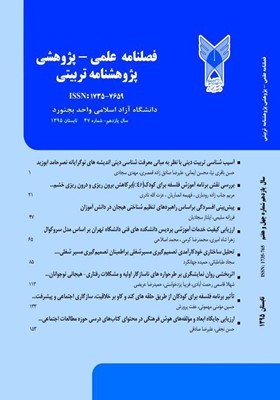پیشبینی افسردگی براساس راهبردهای تنظیم شناختی هیجان در دانش آموزان
محورهای موضوعی : علوم تربیتیفرزانه سلیمی 1 , ایلناز سجادیان 2
1 - کارشناسی ارشد روانشناسی بالینی، دانشگاه آزاد اسلامی واحد اصفهان(خوراسگان)، ایران.
2 - استادیار گروه روانشناسی بالینی، دانشگاه آزاد اسلامی واحد اصفهان(خوراسگان)، ایران
کلید واژه: افسردگی, دانشآموزان, راهبردهای تنظیم شناختی هیجان,
چکیده مقاله :
هدف از پژوهش حاضر تعیین رابطهی راهبردهای تنظیم شناختی هیجان با افسردگی در دانشآموزان دختر پایهی پنجم و ششم ابتدایی در شهر اصفهان در سال تحصیلی 93-94 بود. روش پژوهش توصیفی، از نوع همبستگی و جامعهی پژوهش شامل کلیه ی دانش آموزان دختر پایهی پنجم و ششم مقطع دبستان در شهر اصفهان بود که بر اساس جدول کوهن و همکاران (2000)، 380 دانش آموز به شیوهی نمونهگیری خوشهای چندمرحلهای انتخاب شدند. دادهها با استفاده از پرسشنامهی تنظیم شناختی هیجان گارنفسکی و کرایج (2006) و افسردگی کواکس (1992) گردآوری و با استفاده از آزمون ضریب همبستگی پیرسون و رگرسیون گام به گام مورد تحلیل قرار گرفتند. نتایج نشان داد بین راهبردهای مثبت تنظیم شناختی هیجان (پذیرش، تمرکز مجدد مثبت، تمرکز مجدد بر برنامهریزی، ارزیابی مجدد مثبت، کنار آمدن با دیدگاه) با افسردگی رابطهی منفی معنادار و بین راهبردهای منفی تنظیم شناختی هیجان (سرزنش خود، نشخوار فکری و فاجعهسازی) با افسردگی رابطهی مثبت معنادار وجود داشت (05/0P<). نتایج تحلیل رگرسیون چند متغیری به شیوهی گام به گام نشان داد ارزیابی مجدد مثبت، 10 درصد از واریانس افسردگی (10/0=R2)، نشخوار فکری، 6/9 درصد از واریانس افسردگی (6/9=R2) و پذیرش، 2/2 درصد از واریانس افسردگی (038/0=R2) را تبیین میکند. از یافتههای پژوهش استنباط می شود که راهبردهای تنظیم شناختی هیجان از عوامل مؤثر در تبیین افسردگی است و در مداخلات درمانی باید به آن توجه شود.
The purpose of the current study is to identifying the correlation between cognitive emotion regulation strategies with depression among female students in the fifth and sixth grade of elementary school in Isfahan during the educational year of 2014-2015. The research method was descriptive-co relational and the participants were included the fifth and sixth grade students of elementary school in Isfahan city and among whom 380 female students were selected based on Cohen et al. (2000) by using clustering sampling. The data were gathered by distributing questionnaires of Garnefski & Kraaij's cognitive emotion regulation questionnaire (2006), and Kovacs's depression inventory (1992). The data were analyzed by using Pearson Coefficient Correlation and Step wise Regression. The results showed that there was a significant negative correlation between cognitive emotion regulation strategies (acceptance, positive refocusing, refocusing on planning, positive reappraisal, and putting into the perspective) with depression. Also, there was a positive significant correlation between depression and negative cognitive emotion regulation strategies (blaming, focus on thought and catastrophic) (p<0.05). The multiple regression analysis by using stepwise regression has showed that positive reappraisal explains 10 percentage of variation of depression (R2=0.10) and Focus on thought explains 9/6 percentage of variation of depression (R2=9.6), and acceptance explains 2/2 percentage of variation of depression (R2= 0.038). The findings have showed that attachment and cognitive emotion regulation strategies are the effective factors in depression and should be noticed in preventive planning and therapy interferences.
_||_


